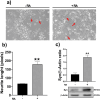Dopamine D1-Like Receptor Stimulation Induces CREB, Arc, and BDNF Dynamic Changes in Differentiated SH-SY5Y Cells
- PMID: 39601897
- PMCID: PMC11602804
- DOI: 10.1007/s11064-024-04293-8
Dopamine D1-Like Receptor Stimulation Induces CREB, Arc, and BDNF Dynamic Changes in Differentiated SH-SY5Y Cells
Abstract
The dopamine D1-like receptor is a dopamine (DA) receptor regulating diverse brain functions. Once the dopamine D1-like receptor is activated, it induces activation of the Protein Kinase A (PKA) that phosphorylates the cAMP Response Element-Binding (CREB) transcription factor, which once active elicits the expression of the critical synaptic elements Activity-regulated cytoskeleton-associated (Arc) and the Brain-Derived Neurotrophic Factor (BDNF). The temporality and subcellular localization of proteins impact brain function. However, there is no information about the temporality of CREB activation and Arc and BDNF levels induced through dopamine D1-like receptor activation. In this study, we aimed to assess the specific effect of dopamine D1-like receptor activation on the temporality of CREB-phosphorylation (p-CREBS133) and the spatiotemporal induction of Arc and BDNF. Using SY-SY5Y cells differentiated with Retinoic Acid (RA), the dopamine D1-like receptor activation with a specific agonist transiently increased p-CREBS133 at 30 min of stimulation. It induced two spikes of Arc protein at 15 min and 6 h, forming clusters near the cell membrane. BDNF secretion temporarily increased, reaching a maximum at 6 h, while secretion was lower at 24 h compared to the unstimulated group. Our results provide new insight into the role of dopamine D1-like receptor activation on CREB activation, Arc, and BDNF increase, showing that these effects occur temporally and for Arc in subcellular specific sites. This study highlights the dopaminergic system as a critical regulator of subcellular events relevant to neuron plasticity. Future research should address the study of the implications for brain function and behavior.
Keywords: Arc; Brain-derived neurotrophic factor; Dopamine D1-like receptor; Protein Kinase A; cAMP response element-binding.
© 2024. The Author(s).
Conflict of interest statement
Declarations. Competing Interests: The authors declare no competing interests.
Figures







Similar articles
-
Brain-derived neurotrophic factor induces long-term potentiation in intact adult hippocampus: requirement for ERK activation coupled to CREB and upregulation of Arc synthesis.J Neurosci. 2002 Mar 1;22(5):1532-40. doi: 10.1523/JNEUROSCI.22-05-01532.2002. J Neurosci. 2002. PMID: 11880483 Free PMC article.
-
BDNF-mediated signal transduction is modulated by GSK3beta and mood stabilizing agents.J Neurochem. 2002 Jul;82(1):75-83. doi: 10.1046/j.1471-4159.2002.00939.x. J Neurochem. 2002. PMID: 12091467
-
Dopamine D3 receptor deletion increases tissue plasminogen activator (tPA) activity in prefrontal cortex and hippocampus.Neuroscience. 2013 Oct 10;250:546-56. doi: 10.1016/j.neuroscience.2013.07.053. Epub 2013 Jul 29. Neuroscience. 2013. PMID: 23906635
-
BDNF mechanisms in late LTP formation: A synthesis and breakdown.Neuropharmacology. 2014 Jan;76 Pt C:664-76. doi: 10.1016/j.neuropharm.2013.06.024. Epub 2013 Jul 2. Neuropharmacology. 2014. PMID: 23831365 Review.
-
BDNF-induced local protein synthesis and synaptic plasticity.Neuropharmacology. 2014 Jan;76 Pt C:639-56. doi: 10.1016/j.neuropharm.2013.04.005. Epub 2013 Apr 16. Neuropharmacology. 2014. PMID: 23602987 Review.
References
-
- Beaulieu J-M, Gainetdinov RR (2011) The physiology, signaling, and pharmacology of dopamine receptors. Pharmacol Rev 63 182 LP– 217. 10.1124/pr.110.002642 - PubMed
-
- Daba Feyissa D, Sialana FJ, Keimpema E et al (2019) Dopamine type 1- and 2-like signaling in the modulation of spatial reference learning and memory. Behav Brain Res 362:173–180. 10.1016/J.BBR.2019.01.028 - PubMed
-
- Granado N, Ortiz O, Suárez LM et al (2008) D1 but not D5 dopamine receptors are critical for LTP, spatial learning, and LTP-Induced arc and zif268 expression in the Hippocampus. Cereb Cortex 18:1–12. 10.1093/cercor/bhm026 - PubMed
MeSH terms
Substances
Grants and funding
LinkOut - more resources
Full Text Sources

